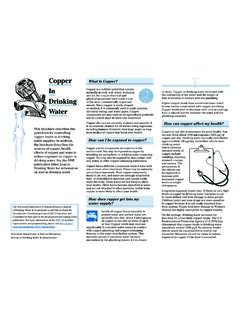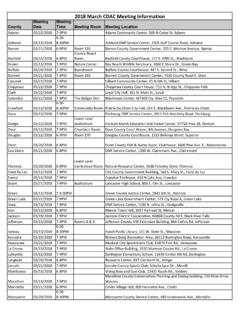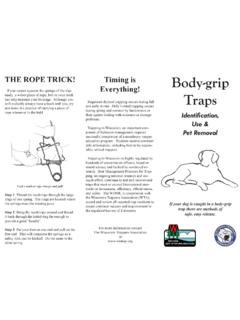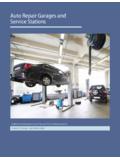Transcription of Recycling and Waste Reduction a Guide for the Workplace
1 For many Wisconsinworkplaces, Recycling hasbecome part of good saves money, preservesvaluable resources and can helppromote your business asenvironmentally friendly. With afew simple changes your businesscan be on the path towardreducing what you throw awayand increasing what you recycle. Why Recycle and Reduce Waste ?To save resources: Recycling saves valuable reusable resources and reduces theenergy use and pollution associated with extracting and manufacturing virginmaterials. To reduce costs: Like other businesses, workplaces pay for Waste disposal.
2 In manycases, Recycling services cost significantly less than trash disposal; companies thatreuse or recycle more Waste can save significant costs on Waste disposal. Reusingmore materials can also reduce purchasing and handling improve customer service: Recycling demonstrates your business commitmentto environmental protection. A recent survey indicates that over 95% of Wisconsincitizens recycle regularly. People now expect to find Recycling containers whereverthey travel. Offering Recycling is just another way to better serve your customers.
3 What Should Be Recycled in Wisconsin?a Guide for the WorkplaceRecycling and Waste Reduction Aluminum, glass, steel (tin) and bi-metalcontainers Plastic containers #1 and #2, includingmilk jugs and detergent, soda and waterbottles Magazines, catalogs and other materialsprinted on similar paper Newspaper and office paper Corrugated cardboard Computers, televisions, desktop printers,computer peripherals, DVD players, VCRs,digital video recorders, fax machines andphones with video displays. Major appliances including airconditioners, clothes washers and dryers,dishwashers, refrigerators, freezers, stoves,ovens, dehumidifiers, furnaces, boilersand water heaters Yard Waste , including grass clippings,leaves, yard and garden debris Lead acid vehicle batteries , automotivewaste oils and Waste tires used oil filtersDesigning Your Recycling and Waste Reduction Program1.
4 Get management supportA Workplace Recycling program does more than help theenvironment and save money. Done right, a recyclingprogram boosts morale and facilitates team support will help stimulate employeeinvolvement in the program and ensure that you get theneeded time, materials and equipment to make theprogram Find a market for what youplan to collectOnce you ve identified whichmaterials you want to recycle, you llneed to find a market or hauler thatwill take your items for property manager or currentwaste hauler may be able to play this role.
5 Your municipal orcounty Recycling office can also help you in finding a marketor recycler. 5. Set up your collectionsystemDevelop a Recycling plan that willmake Recycling easy for your fellowemployees. Because a large part ofyour program s Recycling successwill likely depend on janitors, makesure you involve them in the planning process. Consider: How often should containers be emptied and by whom? How/where will materials be stored before going to aprocessor? Who will be responsible for making sure the right itemsend up in the right bin?
6 Who will be responsible for training of new janitorialstaff?6. Recycling containersChoose Recycling containers thatare easy to recognize (a differentcolor than trash containers) andplace them in high traffic areas andclose to where recyclables aregenerated: near printers andcopiers, in your mail room, at employee desks and in breakand lunch rooms. Wherever possible, place recyclingcontainers next to trash containers. This will help ensureseparation of your recyclables. Recycling and Waste Reduction :a Guide for the Workplace2.
7 Form a Green Team Approaching Recycling as a teamcan help ensure the success of yourprogram. A green team is a group ofemployees interested in recyclingand helping to set up a businesses can accomplishthis with a dedicated individual, while larger businesseswill need a small team with members from management,operations, purchasing, sales, maintenance, Understand your wasteRecycling helps the environmentby recovering valuable resourcesand turning them into newproducts we use every day. Beforeyou start your Recycling program,conduct an audit of yourcompany s Waste .
8 Look through all trash bins for severalweeks. List the types and weights of items customers andstaff throw away. Look for materials that are: Present in significant quantities. Relatively free of contamination (food, glue, etc.). Easily separated from other recycled materials in an office setting include: Commonly recycled materials in retail, warehouse,automotive and manufacturing areas include: Managing wastes cooperativelySmall businesses may want to join together and cooperatively negotiate acontract for trash and Recycling services.
9 As a group, you can benefit fromdiscounts for more materials collected and save money by sharing expenses oncollection fees, storage bins, compactors, balers, transportation and labor. Office and other mixed paper Magazines and catalogs Newspaper Cardboard Aluminum cans Plastic bottles Toner and ink cartridges Computers and otherelectronics Flourescent lightbulbs Cardboard used in shippingand packaging used motor oil, oil filters andoil absorbents Tires Lead acid batteries Scrap metal, plastic and othermaterials Large appliances7.
10 Educate and motivateemployeesYour employees will be a largefactor in ensuring your program ssuccess. Get them involved,informed, and on board with a kick-off program (meeting, potluck, etc.)that emphasizes the benefits of Recycling and the basics ofyour program. To keep employees informed and engaged: Post signs on or near collection containers that clearlyindicate what materials are accepted (illustrations orphotos help). Develop fact sheets or informational posters and postthem on your company s intranet, in break rooms orother common areas.













